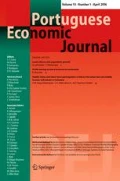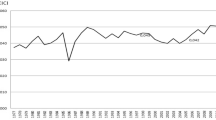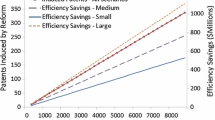Abstract
We propose a directed technical change model with two sectors, clean and dirty, to analyze the impact of the degree of substitutability between sectors and the degree of scale effects on the environmental quality. The technological knowledge is biased towards the clean sector; i.e., the environmental quality is improved whenever the elasticity of substitution between inputs in both sectors increases and, along with that, the economy: (i) is rich in renewable capital, (ii) has higher relative supply of clean labor under scale effects, and (iii) enjoys higher relative R&D productivity in the clean sector. The improvement in the environmental quality benefits the welfare. Moreover, the growth rate is higher in the presence of scale effects.

Similar content being viewed by others
Notes
The aggregate financial wealth held by the representative households is composed of equity of machines/intermediate-goods producers \( B(t)={\sum}_{i={L}_D,{L}_C}{B}_i(t) \), considering the profits seized by the producers of the different machines.
Hereinafter, for simplicity of exposition, the time argument is usually suppressed.
In this paper when we mention “output” we are more precisely referring to the “value added” of the Economy, which, in our case, implies that the role of capital is replaced with machines/intermediate goods.
In the neoclassical growth model without endogenous technological-knowledge change, a positive limit of the declining marginal productivity of productive factors is a required condition for long-run growth. With a CES production functions in a two-factor setting, this means to a constant elasticity of substitution between factors that is larger than one. In standard models of directed technological change, the limit of marginal products plays a similar role since factor intensities continue to change in the long run.
Hence, technological knowledge is not labor saving, meaning that improvements in technological knowledge decrease the marginal product of labor and thus labor scarcity induces improvements in technological knowledge.
Indeed, since \( \dot{A_i}{V}_i={Z}_i \) and \( \dot{A_i}={\lambda}_i\cdotp {Z}_i\cdotp {L}_i^{-{\gamma}_{L_i}} \) it results that \( \dot{V_i}=0 \).
As emphasized in Acemoglu (2010), the relationship between labor scarcity and technological advances can vary over different epochs. The technological-knowledge advances of the late 18th and 19th centuries in Britain and the US were above all labor saving and did induce innovation and technological-knowledge adoption (Habakkuk 1962), while this may no longer be the case in current industrialized economies or even anywhere around the world.
Acemoglu et al. (2016) have shown that using either the R&D expenditures or the number of scientists the estimate results obtained for the innovation production function are identical.
References
Acemoglu D (1998) Why do new technologies complement skills? Directed technical change and wage inequality. Q J Econ 113(4):1055–1089
Acemoglu D (2002) Directed technical change. Rev Econ Stud 69(4):781–809
Acemoglu D (2009) Introduction to modern economic growth. Princeton University Press, Princeton
Acemoglu D (2010) When does labor scarcity encourage innovation? J Polit Econ 118(6):1037–1078
Acemoglu D, Aghion P, Bursztyn L, Hemous D (2012) The environment and directed technical change. Am Econ Rev 102(1):131–166
Acemoglu D, Akcigit U, Hanley D, Kerr W (2016) Transition to clean technology. J Polit Econ 124(1):52–104
Afonso O (2006) Skill-biased technological knowledge without scale effects. Appl Econ 38(1):13–21
Afonso O (2012) Scale-independent north-south trade effects on the technological-knowledge bias and on wage inequality. Rev World Econ 148(1):181–207
Aghion P, Howitt PW, Howitt P, Brant-Collett M, García-Peñalosa C et al (1998) Endogenous growth theory. MIT press, Cambridge
Aghion P, Dechezleprêtre A, Hemous D, Martin R, Van Reenen J (2016) Carbon taxes, path dependency, and directed technical change: evidence from the auto industry. J Polit Econ 124(1):1–51
Alesina A, Spolaore E, Wacziarg R (2005) Trade, growth and the size of countries. In: Handbook of Economic Growth, vol 1. Elsevier, Amsterdam, pp 1499–1542
Atkinson SE, Halvorsen R (1976) Interfuel substitution in steam electric power generation. J Polit Econ 84(5):959–978
Barro RJ, Sala-i-Martin X (2004) Economic growth. MIT Press, Cambridge
Bretschger L, Smulders S (2012) Sustainability and substitution of exhaustible natural resources: how structural change affects long-term r&d-investments. J Econ Dyn Control 36(4):536–549
Calel R, Dechezlepretre A (2016) Environmental policy and directed technological change: evidence from the european carbon market. Rev Econ Stat 98(1):173–191
Canuto O, Cavallari M (2012) Natural capital and the resource curse
Considine TJ (1989) Separability, functional form and regulatory policy in models of interfuel substitution. Energy Econ 11(2):82–94
Davis LS (2008) Scale effects in growth: a role for institutions. J Econ Behav Organ 66(2):403–419
Dinopoulos E, Thompson P (2000) Endogenous growth in a cross-section of countries. J Int Econ 51(2):335–362
Dixit AK, Stiglitz JE (1977) Monopolistic competition and optimum product diversity. Am Econ Rev 67(3):297–308
Elbasha EH, Roe TL (1996) On endogenous growth: the implications of environmental externalities. J Environ Econ Manag 31(2):240–268
Emanuel K (2005) Increasing destructiveness of tropical cyclones over the past 30 years. Nature 436(7051):686
Fuss MA (1977) The demand for energy in Canadian manufacturing: an example of the estimation of production structures with many inputs. J Econ 5(1):89–116
George A (2015) Directed technical change, technology adoption and the resource curse hypothesis. Prague Econ Papers 2015(4):452–472
Griffin JM (1977) Inter-fuel substitution possibilities: a translog application to intercountry data. Int Econ Rev:755–770
Habakkuk HJ (1962) American and British technology in the nineteenth century: the search for labour saving inventions. Cambridge University Press, Cambridge
Hassler J, Krusell P, Olovsson C (2012) Energy-saving technical change. Tech. rep., National Bureau of Economic Research
Hourcade JC, Pottier A, Etienne E (2012) The environment and directed technical change: comment
International Energy Agency (IEA) (2015) World Energy outlook 2015. Paris, France
IRENA (2015) Rethinking energy: renewable energy and climate change. http://www.irenaorg/rethinking/IRENA20_REthinking_Energy_2nd_report_2015.pdf
Jones CI (1995a) R & d-based models of economic growth. J Polit Econ 103(4):759–784
Jones CI (1995b) Time series tests of endogenous growth models. Q J Econ 110(2):495–525
Jones CT (1995c) A dynamic analysis of interfuel substitution in us industrial energy demand. J Bus Econ Stat:459–465
Jones CI (2002) Sources of us economic growth in a world of ideas. Am Econ Rev 92(1):220–239
Kremer M (1993) Population growth and technological change: one million bc to 1990. Q J Econ 108(3):681–716
Landsea CW (2005) Meteorology: hurricanes and global warming. Nature 438(7071):E11
Lanzi E, Sue Wing I (2011) Directed technical change in the energy sector: an empirical test of induced directed innovation. In: WCERE 2010 Conference, mimeo
Mattauch L, Creutzig F, Edenhofer O (2015) Avoiding carbon lock-in: policy options for advancing structural change. Econ Model 50:49–63
Monge-Naranjo A, Sanchez JM, Santaeulalia-Llopis R (2015) Natural resources and global misallocation. Federal reserve bank of st. Tech. Rep., Louis. Working Paper No. 2015–036A
Newell RG, Jaffe AB, Stavins RN (1999) The induced innovation hypothesis and energy-saving technological change. Q J Econ 114(3):941–975
Nordhaus WD (1994) Managing the global commons: the economics of climate change, vol 31. MIT press, Cambridge
Nordhaus WD (2007) A review of the stern review on the economics of climate change. J Econ Lit 45(3):686–702
Organization WH (2016) World health statistics 2016: monitoring health for the SDGs sustainable development goals. World Health Organization, Geneva
Papageorgiou C, Saam M, Schulte P (2017) Substitution between clean and dirty energy inputs: a macroeconomic perspective. Rev Econ Stat 99(2):281–290
Pelli M (2012) The elasticity of substitution between clean and dirty inputs in the production of electricity. Proceedings of the Conference on Sustainable Resource Use and Economic Dynamics (SURED 2012), Ascona, pp 4–7
Peretto P, Smulders S (2002) Technological distance, growth and scale effects. Econ J 112(481):603–624
Perez-Sebastian F, Raveh O (2015) The natural resource curse and fiscal decentralization. Am J Agric Econ 98(1):212–230
Pindyck RS (1977) Interfuel substitution and the industrial demand for energy: an international comparison
Popp D (2002) Induced innovation and energy prices. Am Econ Rev 92(1):160–180
Popp D, Newell R (2012) Where does energy r&d come from? Examining crowding out from energy r&d. Energy Econ 34(4):980–991
Serletis A, Timilsina G, Vasetsky O (2011) International evidence on aggregate short-run and long-run interfuel substitution. Energy Econ 33(2):209–216
Smets F, Wouters R (2007) Shocks and frictions in us business cycles: a bayesian dsge approach. Am Econ Rev 97(3):586–606
Sokoloff KL (1988) Inventive activity in early industrial america: evidence from patent records, 1790–1846. J Econ Hist 48(4):813–850
Steinbuks J (2010) Interfuel substitution and energy use in the UK manufacturing sector
Stern N (2009) A blueprint for a safer planet: how to manage climate change and create a new era of progress and prosperity. Random House, New York
Stokey NL (1998) Are there limits to growth? Int Econ Rev: 1–31
Stott PA, Stone DA, Allen MR (2004) Human contribution to the european heatwave of 2003. Nature 432(7017):610
Strulik H, Prettner K, Prskawetz A (2013) The past and future of knowledge-based growth. J Econ Growth 18(4):411–437
Trabandt M, Uhlig H (2011) The laffer curve revisited. J Monet Econ 58(4):305–327
Van der Werf E (2008) Production functions for climate policy modeling: an empirical analysis. Energy Econ 30(6):2964–2979
Vissing-Jørgensen A (2002) Limited asset market participation and the elasticity of intertemporal substitution. J Polit Econ 110(4):825–853
Acknowledgements
This research has been financed by Portuguese public funds through FCT - Fundação para a Ciência e a Tecnologia, I.P., in the framework of the projects with reference UIDB/04105/2020, UIDB/05037/2020, and UID/MAT/00144/2019. The fourth author acknowledges the support from FCT through the Sabbatical Fellowship SFRH/BSAB/142986/2018.
Author information
Authors and Affiliations
Corresponding author
Additional information
Publisher’s note
Springer Nature remains neutral with regard to jurisdictional claims in published maps and institutional affiliations.
Appendices
Appendix 1. Final good prices in the two sectors
From the maximization problem max π = Y − PDYD − PCYC, with \( Y={\left({\varsigma}_D{Y}_D^{\frac{\varepsilon -1}{\varepsilon }}+{\varsigma}_C{Y}_C^{\frac{\varepsilon -1}{\varepsilon }}\right)}^{\frac{1}{\varepsilon -1}} \), the first-order condition with respect to YD
reveals that the price of the final good in the D-Sector is,
Similarly for the C-sector, from the first-order condition with respect to YC, we obtain
Finally, Eq. (4) is easily obtained
Appendix 2. Inverse demand for labor derivation
Considering \( \mathit{\max}\ {\pi}_D={P}_D{Y}_D-{w}_D{L}_D-{\int}_0^{A_D}{q}_D(j){x}_D(j) dj \), where \( {Y}_D=\frac{L_D^{\alpha}\cdotp {R}^{\beta }}{1-\alpha -\beta }{\int}_0^{A_D}{x}_D{(j)}^{1-\alpha -\beta } dj \) (5), the first-order conditions yields
and thus \( {w}_D=\alpha \frac{P_D}{L_D}{Y}_D \);
and thus \( {x}_D(j)={\left(\frac{P_D}{q_D(j)}{L}_D^{\alpha }{R}^{\beta}\right)}^{\frac{1}{\alpha +\beta }} \). Plugging the latter into the former, it results that
Appendix 3. Relative price of the C-factor deduction
From (4) \( \frac{P_C}{P_D}=\frac{\varsigma_C}{\varsigma_D}{\left(\frac{Y_C}{Y_D}\right)}^{-\frac{1}{\varepsilon }} \), and bearing in mind (11) and (12), we obtain
and, therefore, Eq. (17) is recovered
Appendix 4. Relative return on clean-skilled capital deduction
Combining Eqs. (13), (14), and (17) we get
Appendix 5. Relative profitability of innovators in the C-sector deduction
Dividing Eq. (16) by (15) and combining with (17) we have
Equation (19) is thus recovered.
Appendix 6. Directed technical change result
Solving Eq. (19) with respect to \( \frac{A_C}{A_D} \), yelds
which meets Eq. (22).
Appendix 7. Skill premium deduction with directed technical change
Substituting (22) into (18), we obtain
Equation (23) is thus deduced.
About this article
Cite this article
Afonso, Ó., Fonseca, L., Magalhães, M. et al. Directed technical change and environmental quality. Port Econ J 20, 71–97 (2021). https://doi.org/10.1007/s10258-020-00174-4
Received:
Accepted:
Published:
Issue Date:
DOI: https://doi.org/10.1007/s10258-020-00174-4
Keywords
- Directed technical change
- Clean and dirty sectors
- Substitutability
- Scale effects
- Wage inequality
- Environmental quality




